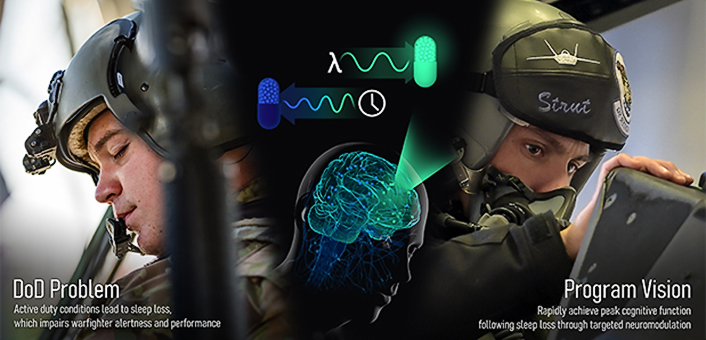DARPA’s AWARE aims to achieve the benefits of stimulants on alertness without the negative effects on mood, restorative sleep, and mental health.
DARPA is pursuing a rare program to enhance military personnels’ cognitive performance that is otherwise degraded by fatigue and lack of sleep. The BTO (Biological Technologies Office), on Jun. 17, 2024, held a Proposers’ Day conference seeking general ideas from industry and the scientific community towards what it has coined as the AWARE (Alert WARfighter Enablement) program.
AWARE, announced late in May, “aims to develop a combination drug and device to non-invasively increase alertness following sleep loss in humans, without negative side effects such as anxiety, irritability, or euphoria, and with reduced addictive potential.” AWARE also includes an ELSI (ethical, legal, and societal implications) plan to discuss the technology’s human use.

The new stimulant is envisaged to be a “photoswitchable drug […] behaving in the same manner as regular [i.e., non-photoswitchable] dextroamphetamine,” and delivered through a device producing NIR (Near-Infrared Light) […] to specific areas of the brain.” The NIR should hit “regions of the prefrontal cortex responsible for executive function, working memory, and decision making, while avoiding deep brain structures such as the amygdala and striatum, which have been implicated in mood alterations and euphoria, respectively.”
To foster the pool of innovative proposal concepts, DARPA encourages participation by non-traditional performers like small businesses, academic and research institutions, and first time government contractors. The program’s timeline is spread out over a three-year period, with the Phase 0, Phase 1 and Phase 2, each expected to last 15, nine and 12 months respectively.

Current drugs
DARPA recognizes the current use of prescription drugs like modafinil and dextroamphetamine for maintaining alertness for long-duration training or missions. Studies have demonstrated dextroamphetamine to exhibit “superior performance on vigilance tasks following sleep loss.”
The drug achieves this through an “increased concentration of extracellular dopamine in the brain.” However, it has side effects like either increased irritability or euphoria, creating suitable conditions for addiction. Moreover, dextroamphetamine’s long circulation time of 10 to 12 hours might impact sleeping, while military personnel are encouraged to nap at opportune times.
Sedatives, used to facilitate sleep, cannot counteract the lingering effects of stimulants to enable restorative sleep on demand. Naturally, a cumulative loss of restorative sleep not only impacts alertness and cognition but also metabolic, immune and mental health.
‘Light’ stimulant without the side-effects
AWARE envisages developing a “photoswitchable version of dextroamphetamine” that is activated only by NIR, allowing “high spatial and temporal resolution.” The NIR light allows it to spare deep brain structures like the amygdala and striatum responsible for mood alteration and euphoria.
The AWARE technology operates on temporal selectivity, enabling reversible activation of the drug precisely when needed. Moreover, temporal arrangement of NIR light pulses may be used to titrate the dose of activated drug over time, which can further reduce the potential for addiction and other undesirable effects. Importantly, the temporal selectivity of “switching the drug from an active to inactive state” is anticipated to “facilitate on-demand de-transition from alertness and make restorative sleep possible,” said the DARPA document.
A statement from DARPA quoted the AWARE program manager, Dr. Pedro Irazouqi. “To achieve the beneficial effects of stimulants on alertness without the undesirable effects on mood, restorative sleep, and mental health, a new approach is needed,” said Irazouqi. “AWARE aims to modify currently approved prescription drugs to make them photoswitchable – to have the ability to change using light – and to develop wearable light emitters to rapidly activate them in a localized area.”
Program course
In Phase 0, after assessing various proposals, teams will be assigned to either Technical Areas 1 or 2 (TA1 and TA2). TA1 aims to develop candidate photoswitchable dextroamphetamine (“PhotoDex”) molecules that are “biologically inert in dark conditions” but activated by “850-nm NIR light.” Teams must also submit ASR (Animal Subject Research) protocols.
TA2 involves developing “wearable transducers that emit 850-nm NIR light” to non-invasively reach the human prefrontal cortex with “mm-scale resolution,” demonstrated on a “tissue-mimicking phantom of human scalp, skull, and brain tissue.”
Use on battlefield
Many tactical military engagements have demonstrated that human performance and cognitive skills often decide the outcome, rather than technological superiority. This trend is evident in the ongoing skirmishes in the Black Sea between Ukrainian unmanned kamikaze boats and Russia’s Black Sea Fleet (BSF), as well as the exchanges between the U.S. Navy and Houthi projectiles in the Red Sea.
Ukraine’s kamikaze USVs (Unmanned Surface Vessels), despite being destroyed in large numbers, occasionally achieve devastating hits. These attacks are successful because they are planned with unpredictable timing and frequency, keeping Russian watch and gunnery crews on high alert.
Similarly, in the Red Sea, Western reports highlight overworked aircraft carrier and destroyer crews dealing with volleys of Houthi Anti-Ship Ballistic Missiles (ASBMs), cruise missiles, and drones. Sometimes, these missiles are intercepted using Close-In Weapons Systems (CIWS) like the Phalanx, indicating they have breached the outer layers of defense.









